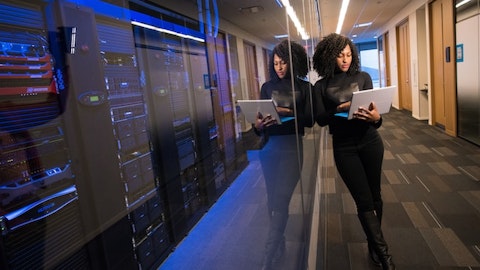It’s a question of replicating that across the entire portfolio of programs we have.
Jason Gursky: Okay. Great. And then just as a follow-on, I just want to make sure I understand this. You get more focus here on recompetes and having a better win rate on that, you’re increasing the pipeline by 25%, and yet we’re still looking at 2% to 4% growth coming out the back end of things. It seems to me is maybe just a general comment you can comment on, but that the risk would be that, that 2% to 4% moves higher over time given the count you’re successful in these first two things. So first, I just want to confirm that. And then secondly, if you are successful with this pipeline, you’re growing at 25% and your win rates end up being as good or better than they have been historically, do you have the people in place, the ability to scale?
Can you grow fast? And will you be able to actually fulfill all of that demand should it come in? And maybe that’s an indication that you’re kind of you’ve got some underutilized people around today, and we ought to see some really nice OpEx leverage that comes with it. So just kind of generally, you win all of this, then what happens? How do you execute on it? What happens to margins when you do? Thanks.
Prabu Natarajan: Great question, Jason. I’ll take the first part and defer to Toni on the second one. On the first part, look, I think the expectation is that the investments we are making will translate to better returns in the out years. And obviously, as you probably noticed, we provided FY ‘25 and FY ‘26 guide. We’ve held back on providing FY ’27, that’s obviously a topic of discussion at our Investor Day in April, but I think it seems to make sense to assume that we would expect a higher level of EBITDA growth and cash growth from the investments we’re making than there is currently. The 25% comment that you referred to, that was really an improvement in the submission number as opposed to improvement in the pipeline number.
Our pipeline is, as you think about kind of a TCV here of the pipeline, we’re in that circa $80 billion to $100 billion. But we are explicitly talking about submission rates improving by at least 25% in FY ’25 and relative to FY ’24. And so to me, I just want to make sure we’re clear on exactly what we’re improving, but I think it’s a fair comment that you should expect our EBITDA and cash performance to improve relative to what we’ve got out there in the long-term. Toni?
Toni Townes-Whitley: Yes. And Jason, let me take the second part of that question in terms of the human capital supply, meeting the demand, increased demand as a function of prosecuting all of this new pipeline in a positive way for SAIC. So really, there’s sort of two responses there. First, in terms of talent acquisition, SAIC relative to the market, is in a leadership position on talent acquisition, days to fill and our ability fill open requisitions. In fact, it was underpinning some of our average performance in Q4 was a positive labor market and our ability to execute very well on talent acquisition and quite frankly, the lowest attrition we’ve had in the company over the last couple of years. So in that regard, our ability to go get talent from the market and retain top talent, I think, has been proven, and we obviously have to sustain that.
Secondarily, you heard my investment relative to upskilling. And that is the conversation that we have got to in each one of our business groups is engaging in upskilling initiatives even across our various functions in the company to ensure that we can’t just acquire all of the talent we need. We have to incubate that talent. And so we are upskilling in critical areas. Those upskilling areas generally align with where our differentiation is in our portfolio. So upskilling in a cloud area, upskilling and data analytics, upskilling and AI. Those are all the support the actual enterprise differentiation that we are investing in and expect a significant return in from our portfolio. Hopefully, that answers your question on human capital.
Jason Gursky: Great. I appreciate it. Thanks everybody.
Operator: Your next question comes from the line of Greg Konrad with Jefferies. Your line is open.
Greg Konrad: Good morning, thanks for the question.
Prabu Natarajan: Good morning, Greg.
Greg Konrad: Maybe just to kind of follow-up on the last question. But you mentioned a 12- to 18-month cycle, but also that an increase of at least 25% in submitted bids in fiscal year ’25. Just thinking about the strategy that you laid out, I mean how much of that is maybe market growth versus early returns on going after green space and expanding the aperture of what you bid on? And then with that, how do you kind of think about that number trending forward as you execute on the strategy?
Prabu Natarajan: Yes. Hey Greg, I’ll take the first part of it here. So in terms of just the aperture, we see these as less about green space development. I think this is core to the pipeline we’ve built over the last few years. I think they are maturing to a place where I think we’re actually in a place to more readily bid these things with the right solutions inside of the factories. So I would say less in the way of new adjacencies more in the way of where kind of the core capability investments are being made inside the company.
Toni Townes-Whitley: And we’ve already been able to confirm we have a significant addressable market. So before we need to look to any sort of adjacency, we’ve got the ability to bid. We’re going to lay out sort of those growth vectors in our Investor Day to show what’s driving the strategic bid thesis. But that’s the way we are looking to drive this additional bid volume is not only as Prabu will speak to, this is about vitamins and not calories. It’s not just bidding for bid’s sake. High bid, high strategic bids and, quite frankly, processes that can monitor that we are bidding on strategy in a routine manner.
Greg Konrad: And then maybe just one quick follow-up. Thinking about those differentiators, I appreciate that. When you think about those vectors, how much of this is based on or how aligned is where you think you can compete better versus maybe where the market has the most growth? I mean, are those two areas aligned when I think about things like AI or is it more about where you think you compete? Or is that about where you think the markets may be going the most?
Toni Townes-Whitley: Greg, that’s a phenomenal question. I appreciate it because it allows me to speak to how the strategy is built and how growth vectors are identified or a combination of where we have footprint and capability, what we are both in terms of contracts that we may currently have but also solution capability that’s meeting the need for and the express demand of that customer set as well as where there are parts of the market that are growing. The underpinning. And so they come together, and it is a multifactor equation — there are parts of the market that are growing. The underpinning. And so they come together, and it is a multifactor equation for us to identify growth vectors. So when you think about secure multi-cloud, one of our key differentiators the fact that we have Cloud One of the largest cloud contracts in the Department of Defense, one of the largest cloud contracts in the civilian market at treasury the fact that we’re there and we have cloud capability, and we have a unique offering in cloud and the brokerage and security of our cloud, that is not only an area of differentiation for us.
It’s also one of the fastest growing markets across both defense and civilian in the federal government. And so it is both that are part of the equation of how we identify a growth vector. And that’s why we get pretty excited and engaged about our opportunity to take share in those areas.
Greg Konrad: Appreciate it. Thank you.
Prabu Natarajan: Appreciate it.
Toni Townes-Whitley: Thanks Greg.
Prabu Natarajan: Thank you.
Operator: Your next question comes from the line of Bert Subin with Stifel. Your line is open.
Bert Subin: Hey good morning, Prabu and Tony. Thank you for the questions.
Prabu Natarajan: Good morning.
Toni Townes-Whitley: Good morning.
Bert Subin: Maybe just sort of focusing on the internal investment strategy. If we think about the life cycle of winning new meaningful government contracts, that can be a multiyear process from the initial solicitation to a point where it’s actually contributing to revenue. So as I think about ramping internal investment, the payback period is probably a couple of years out. With that in mind, as we contemplate Prabu, what seems to be a little bit of a lower buyback assumption and a lower projected leverage ratio, is that a function of SAIC positioning to be more acquisitive to perhaps accelerate some of that internal growth return?




